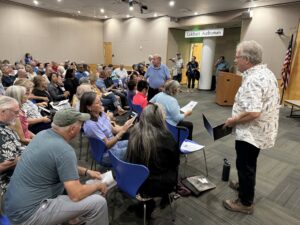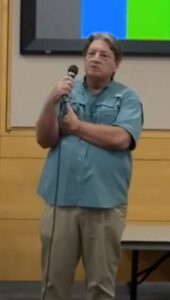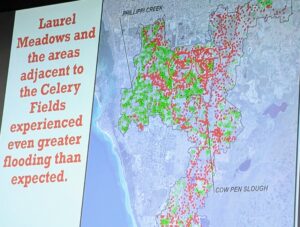Sarasota hydrologist has an idea. And what to do next.
By Ramon Lopez
Original Air Date: October 25, 2024
Host: Laurel Meadows is a fairly new subdivision in suburban Sarasota and it is far from any bigger body of water. So what caused it to be knee deep under water after Tropical Storm Debby? Hydrologist Steve Suau found a smoking gun, and now, in a study commissioned by Sarasota County, he has a series of recommendations on how to prevent similar damage during the next floods. Ramon Lopez has the details.
Ramon Lopez: Just what, or who, is responsible for the devastating and widespread area flooding in the wake of Hurricane Debby remains the subject of much public debate. Large sections of Sarasota County were flooded for days after the storm, causing evacuations of entire communities. Especially hard hit was the Laurel Meadows neighborhood. Residents point to overdevelopment. Real estate moguls say the “unprecedented” volume of hurricane-produced rainfall was to blame. Local government officials cite the county’s current stormwater regs and control systems, saying they were simply “overwhelmed”.
Currently, the county adheres to what is often referred to as a 100-year storm threshold of 10 inches of rain in a 24-hour period to determine acceptable flooding in certain areas. In the aftermath of the Debby deluge, Public Works Department staffers told Sarasota County commissioners there was simply too much rain — up to 18 inches in some areas of the county — over a three-day period for the infrastructure to handle.

Damaged homeowners are seeking answers. Suau and the SCAN organizers drew an overflow crowd to the auditorium of Selby Library.
In August, Commissioner Mark Smith suggested it may be time to update the county’s standards. And a petition was presented to the commissioners calling for a hydrology study, a pause in land-use changes in floodplain areas, and a wastewater spillage and prevention plan to be initiated immediately. But the citizens’ plea fell on deaf ears, as the county commissioners cleared the way for the 2,700 acre 3H Ranch project with a whopping 6,500 houses, 250,000 square feet of commercial space and 120,000 square feet of office space.
Given there were three punishing rain events this past summer in less than 100 days — much less 100 years apart — that met or exceeded that standard, the guideline is set to be scrutinized in January, after two new county commissioners are sworn in. At issue is whether the Public Works Department’s storm water regulations are stringent enough to prevent the severe flooding seen during Debby.
Thursday night at Selby Library, SCAN — an anti-growth organization that has long warned about the environmental risks of unchecked suburban sprawl — hosted Steve Suau, an outspoken former Sarasota County stormwater engineer. He revealed to several hundred concerned citizens the findings and recommendations of his independent report on the unexpected flooding arising after Hurricane Debby.

Steve Suau
Steve Suau: I got a call on Friday — It would have been August 7th, I think — from Spencer Anderson, the public works director of Sarasota County. And I haven’t really been involved with them for 20, 25 years, asking if I would consider doing an independent third-party review of what the flooding was. And he was pretty open saying, “You know, we need to know what happened. If we did some things wrong, we need to know that.” And I thought about it over the weekend and got very intrigued, particularly by some of the severe flooding that happened because some of it didn’t make sense, to be honest with you. And Laurel Meadows, I was seeing it on the news for example, and in thinking about it, I realized that something that very unusual might have happened.
RL: Suau said the 100-year storm threshold was no match to Debby’s high water mark.
SS: What I looked at then was comparing this 100-year storm to Debby was Debby was more rainfall. It may not have been quite as intense at times in what we saw. And then we compared the two and then we looked at: if the 100-year storm was higher, it’s a green dot; If Debby was higher, it’s a red dot. So, it’s a mismatch. You can see in a lot of locations, Debby resulted in flood stages, I think, as much as over a foot, a little over a foot higher than this 100-year storm. And those generally happen in low lying areas. This is the Celery Fields, this is the [unintelligible] valley, this is the other area out east in Cow Pen Slough, very sluggish. So, if it was in a low lying area, typically the more rain that fell, the higher the flood level.
RL: Based on good detective work, Suau figured out why the Laurel Meadows neighborhood was especially hard hit.
SS: I just wanted to touch on two other things that have been somewhat of anomalies for this heavy storm that I saw, was Laurel Meadows, as I mentioned, and then areas adjacent to the Celery Field. These two areas experienced even greater flooding than expected or predicted. Why?

Suau overlayed Sarasota County’s “100-year storm” flood forecasts with actual flooding during Debby. Red dots show higher-than-expected levels.
For Laurel Meadows, and this was the real puzzler, but over the weekend after Spencer called me and I saw on the news what was happening out there, I got to thinking that something was putting a lot of water in here. And I hypothesized that, I looked in the flood levels over on this side in Cow Pen Slough, which is on the east side of kind of the Philippi Creek dike creek line, are several feet higher than they are in Philippi Creek. So I hypothesized that somewhere, somehow, that dike had been breached. And water will seek to level it. If it’s higher over here, it’s going to flow through that breach. And once it gets through it, it’s going to drain up through this way, over Delft Road, and then make a straight byline for the ditch and where Laurel Meadows is.
And I told them, go out to the end of Delft Road, and just go south and it’s got to be down there somewhere. By the end of the day, they found it. And they sent me a little video of it. And it was right down in this area here. Now this is that LiDAR that I mentioned that kind of looks at — this is from 2018, I think. And it’s showing that it’s been there for a little while. Five or six years. And when I looked at the video, you could see, that it was like Brazilian peppers and woody plants that were in the breach. So it wasn’t clean. Stuff had been growing up in it. The good news is, if you live in Laurel Meadows, that dike, that breach has been fixed. It was fixed before Helene.
RL: Based on his detailed study, Steve Suau has developed draft recommendations to be presented to Sarasota County. They include: Build more internal stormwater staff expertise, proactively protect significant floodplain areas, update storm criteria, update rainfall volume regulations, make maintenance of the stormwater infrastructure more transparent to the public.
Suau had one additional recommendation:
SS: From a policy standpoint, I think we need to be much more careful increasing density in flood prone areas for too long [applause, hollers]. There’s been this notion … Well, we have these computer models and the development code that will take care of it, and that’s not fair.
RL: It remains to be seen whether Steve Suau’s recommendations will be adopted, but he is hopeful.
This is Ramon Lopez for WSLR News.
WSLR News aims to keep the local community informed with our 1/2 hour local news show, quarterly newspaper and social media feeds. The local news broadcast airs on Wednesdays and Fridays at 6pm.